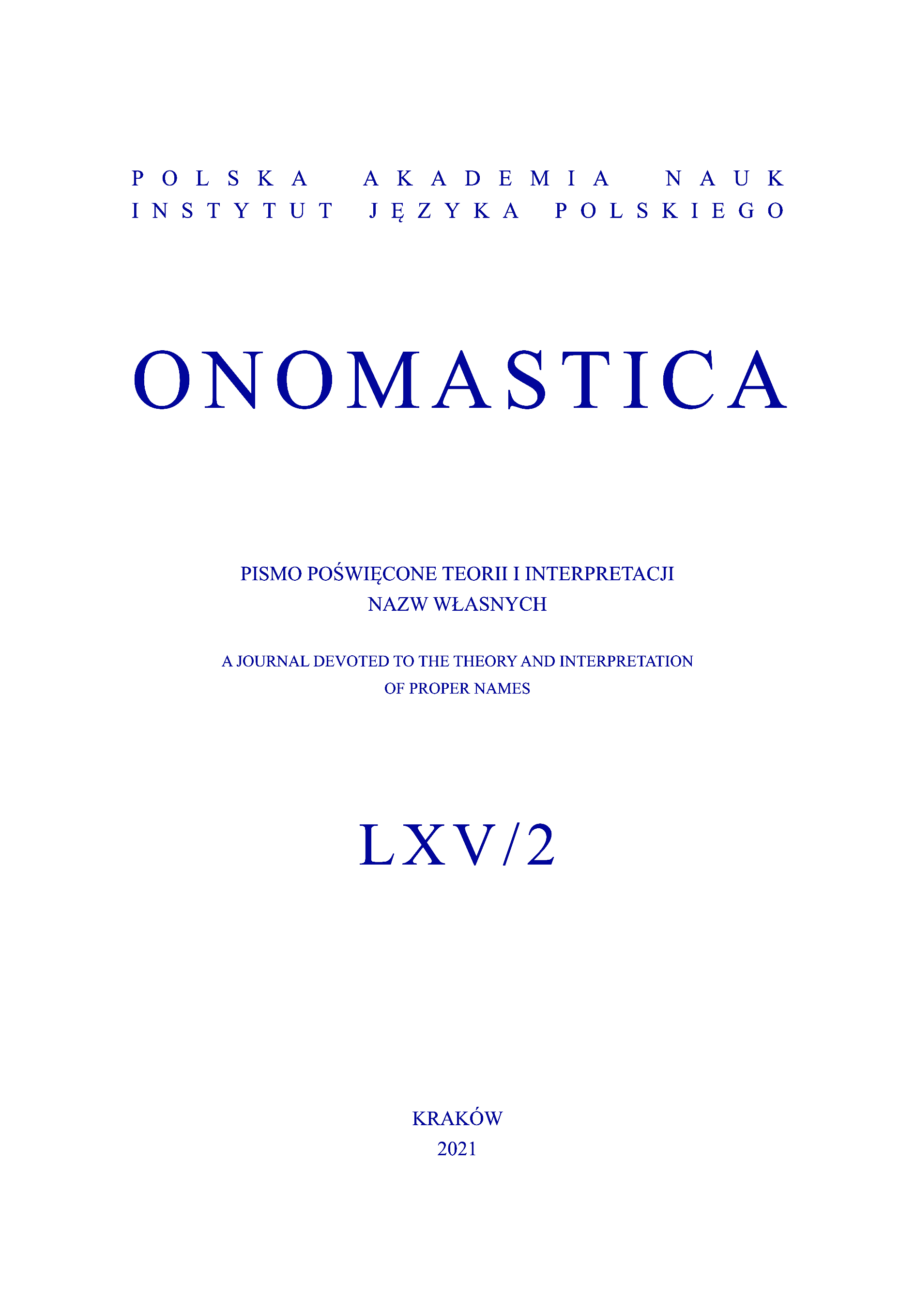Streszczenie
Celem artykułu jest podjęcie odwiecznej kwestii: co to jest nazwa własna. Niemniej jednak tak stawiane pytanie wydaje się błędnie sformułowane. Pytać należy bowiem raczej o istotę proprialności i o kryteria używane w ocenie stopnia proprialności danego znaku językowego. W niniejszej pracy nazwę własną definiuje się jako bilateralny znak językowy składający się ze strony znaczącej (onim lub forma onimiczna) oraz ze strony znaczonej. Na tej podstawie wyróżniono następnie kilka możliwych typów znaczeń obecnych wewnątrz pojedynczej nazwy własnej: znaczenie denotacyjne, referencyjne, etymologiczne oraz strukturalne. Te ustalenia tworzą ogólny układ odniesienia dla klasyfikacji kryteriów proprialności dających się wydobyć z wybranych prac polskich przedstawicieli onomastyki materiałowej. W końcowej części pracy zaproponowano koncepcję wielobiegunowej „przestrzeni proprialności” jako zespołu kilku osobnych skal, na których możliwe jest oznaczanie poziomów proprialności każdego pojedynczego znaku językowego.
Bibliografia
Bijak, U. (2020). Pluralia tantum w polskiej ojkonimii (specyfika, typologia, formy) [Pluralia tantum in the Polish oikonymy (specificity, typology, forms)]. Folia onomastica Croatica, 29, 1–13. https://doi.org/10.21857/9e31lhvxpm
Blanár, V. (1976). Lingvistický a onomastický status vlastného mena [Linguistic and onomastic status of a proper name]. Onomastica, 21, 5–18.
Gajda, S. (2004). Narodowokulturowy składnik znaczenia nazw własnych w aspekcie edukacyjnym [National and cultural component of the meaning of proper names in the aspect of education]. W: R. Mrózek (red.), Nazwy własne w języku, kulturze i komunikacji społecznej [Proper Names in Language, Culture, and Social Communication] (s. 21–28). Katowice: Wydawnictwo UŚ.
Gałkowski, A. (2011). Chrematonimy w funkcji kulturowo-użytkowej. Onomastyczne studium porównawcze na materiale polskim, włoskim i francuskim [Chrematonyms in the Cultural-functional Context. An Onomastic Comparative Study Based on Polish, Italian and French Resources] (wyd. 2). Łódź: Wydawnictwo UŁ.
Górnowicz, H. (1979). Nazwy własne polskich jednostek wojskowych [Proper names of Polish military units]. Poradnik Językowy, 8, 369–386.
Górny, W. (1957). Zagadnienie polskiej gramatyki onomastycznej [The question of the Polish onomastic grammar]. Język Polski, 37, 174–178.
Kucała, M. (1967). Co już jest, a co jeszcze nie jest nazwą własną [What already is a proper name and what is not yet]. Onomastica, 12, 153–161.
Lubaś, W. (1963). Nazwy terenowe powiatów jasielskiego i krośnieńskiego [Field names of the Jasło and Krosno Counties]. Onomastica, 8, 195–236.
Lubaś, W. (1983). Próba socjolingwistycznej definicji nazwy terenowej [An attempt at creating a sociolinguistic definition of a name of an uninhabited geographical feature]. W: K. Rymut (red.), Geografia nazewnicza [Geography of Names and Naming] (s. 19–26). Wrocław–Warszawa– Kraków: Zakład Narodowy im. Ossolińskich.
Nikonov, V.A. (1965). Vvedenie v toponimiku [Introduction to Toponomastics]. Moskva: Nauka.
Rutkiewicz-Hanczewska, M. (2013). Genologia onimiczna. Nazwa własna w płaszczyźnie motywacyjno-komunikatywnej [Onymic Genology. Proper Names on the Motivational and Communicational Level]. Poznań: Wydawnictwo Poznańskie.
Włoskowicz, W. (2015). Trójelementowy model znaczenia onimicznego i pojęciowy model onomastykonu [The triple model of onymic meaning and the conceptual model of onomasticon]. Onomastica, 59, 57–76. https://doi.org/10.17651/ONOMAST.59.3
Wolnicz-Pawłowska, E. (2014). Nazwy własne w przekładzie. Zarys problematyki [Proper names in translation. An outline of key topics]. Poznańskie Spotkania Językoznawcze, 27, 201–214. https://doi.org/10.14746/psj.2014.XXVII.17


